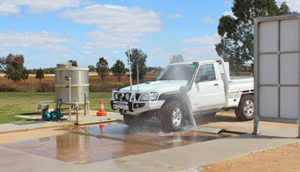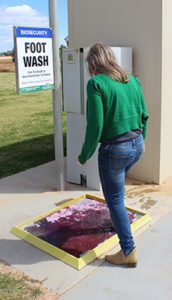Read the latest information on
Foot-and-mouth disease

Each time you include an aspect of biosecurity in your actions, you are taking a step towards securing your farm against diseases, pests and weeds
With a number of plant pest incursions on the go across Australia, many producers in the affected areas are turning to on-farm biosecurity measures in an attempt to prevent the disease or pests from affecting their property.
Stuart Kearns, Manager for Farm Biosecurity Programs at Plant Health Australia, would like to see some of the biosecurity measures that growers in areas where there is an active eradication effort underway become the norm for all producers.
“Don’t wait until you have a problem with a pest to start implementing biosecurity measures on your property,” said Stuart.
“It can seem daunting at the start when you’re looking to do it all at once. But it isn’t difficult if you apply practical biosecurity measures to what you are already doing on farm,” he said.
Biosecurity is less complicated when it is built into daily routines or seasonal activities and is easy to follow. It need not be costly.
“Think about what you do on-farm, and then start thinking about it from a pest or disease perspective and what you can do to reduce their spread,” advised Stuart.
 “Each time you include an aspect of biosecurity in your actions, you are taking a step towards securing your farm against diseases, pests and weeds,” he added.
“Each time you include an aspect of biosecurity in your actions, you are taking a step towards securing your farm against diseases, pests and weeds,” he added.
“If you are not sure about something, agronomists, rural suppliers or staff from the local state department of primary industries are a good source of biosecurity information. There’s a growing number of biosecurity officers available to provide advice to growers who want to talk to someone about biosecurity.”
There’s also a range of tailored planners – based on the Farm Biosecurity Action Planner – available now for growers of a variety of crops.
Tasmanian Farmers and Graziers Association has recently released two for growers of grains and horticultural crops.
And the NSW Department of Primary Industries has worked with Rice Extension, the Australian Melon Association, and the Australian Blueberry Grower’s Association to create customised planners for rice, melon, blueberry and other berry growers (see below for links).
The grower checklists that are part of several plant biosecurity manuals are also a good way to get started on implementing biosecurity measures on-farm and to prioritise actions. The checklists for growers of onions and potatoes are good examples of this.
 For biosecurity checklists and planners go to the Profiler page on the Farm Biosecurity website and select the crops that apply to you. The profiler collects the resources relevant to you and presents them all in the one place.
For biosecurity checklists and planners go to the Profiler page on the Farm Biosecurity website and select the crops that apply to you. The profiler collects the resources relevant to you and presents them all in the one place.
“Don’t wait until you find yourself in the midst of an emergency pest response to start implementing biosecurity measures,” said Stuart.
“The more prepared you are beforehand the less impact an incursion could have on your business and the sooner you will be able to return to normal.”
On-farm Biosecurity Planner – grains and seeds (Tasmanian Farmers and Graziers’ Association)
On-farm Biosecurity Planner – horticulture (Tasmanian Farmers and Graziers’ Association)
Farm Biosecurity Planner for the Melon Industry (NSW DPI and Australian Melon Association)
Farm Biosecurity Planner for the Rice Industry (NSW DPI and Rice Extension)